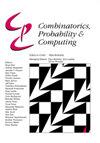Studies on the Temperature Stability of Pure and Doped Triglycine Sulphate Crystals Using TGA/DTA
IF 0.8
4区 数学
Q3 COMPUTER SCIENCE, THEORY & METHODS
引用次数: 0
Abstract
To study the temperature stability of TGS doped with ZnSO4, CdCl2, BaCl2, and compare it with that of pure TGS. Synthesizing pure and doped TGS and studying their temperature dependence using TGA, DTA, and DSC analysis. Slow cooling solution growth was used to grow single crystals of pure and doped TGS. The TGA, DTA and DSC analysis was conducted for determining the temperature stability. The thermal analysis of pure and doped TGS shows that the doped samples show a similar dependence on temperature as pure TGS. The temperature of decomposition of pure and doped samples (BTGS, ZTGS, CdTGS) was 226.60°C, 228.38°C, 229.13°C, and 239.13°C respectively. The melting onset of these samples was 214.51°C, 216.04°C, 217.69°C and 216.04°C respectively. The study shows that doping TGS with the above three described materials did not alter their temperature stability considerably. It is a good result as doping TGS, for varying its characteristics like absorbance, reflectance, bandgap energy, etc., which did not alter its temperature stability. Therefore, TGS doped with the above three dopants can be used at the same temperature ranges as of pure TGS but with much-improved efficiency.TGA/DTA研究纯和掺杂硫酸三甘酯晶体的温度稳定性
研究了ZnSO4、CdCl2、BaCl2掺杂TGS的温度稳定性,并与纯TGS进行了比较。合成纯TGS和掺杂TGS,并用TGA、DTA和DSC分析研究它们的温度依赖性。缓慢冷却溶液生长用于生长纯TGS和掺杂TGS的单晶。通过热重分析、差热分析和差热扫描量热分析测定了其温度稳定性。纯TGS和掺杂TGS的热分析表明,掺杂样品与纯TGS表现出类似的温度依赖性。纯样品和掺杂样品(BTGS、ZTGS、CdTGS)的分解温度分别为226.60°C、228.38°C、229.13°C和239.13°C。这些样品的熔化起始温度分别为214.51°C、216.04°C、217.69°C和216.04℃。研究表明,用上述三种材料掺杂TGS不会显著改变其温度稳定性。由于TGS的吸收率、反射率、带隙能量等特性的变化,并没有影响其温度稳定性,因此掺杂TGS是一个很好的结果。因此,掺杂有上述三种掺杂剂的TGS可以在与纯TGS相同的温度范围下使用,但效率大大提高。
本文章由计算机程序翻译,如有差异,请以英文原文为准。
求助全文
约1分钟内获得全文
求助全文
来源期刊

Combinatorics, Probability & Computing
数学-计算机:理论方法
CiteScore
2.40
自引率
11.10%
发文量
33
审稿时长
6-12 weeks
期刊介绍:
Published bimonthly, Combinatorics, Probability & Computing is devoted to the three areas of combinatorics, probability theory and theoretical computer science. Topics covered include classical and algebraic graph theory, extremal set theory, matroid theory, probabilistic methods and random combinatorial structures; combinatorial probability and limit theorems for random combinatorial structures; the theory of algorithms (including complexity theory), randomised algorithms, probabilistic analysis of algorithms, computational learning theory and optimisation.
 求助内容:
求助内容: 应助结果提醒方式:
应助结果提醒方式:


